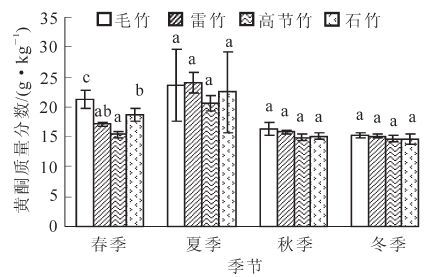-
竹子为禾本科Poaceae竹亚科Bambusoideae多年生常绿植物,在中国分布很广,资源十分丰富[1-2]。竹子在建筑、水利、农业等领域都有广泛的应用,然而,竹子加工利用后,竹叶却总是被弃置,造成了极大浪费[2]。竹叶中含有多种活性物质,其主要活性物质是黄酮类物质,平均质量分数为2%[3]。研究发现,其清除DPPH·(2,2-二苯基-2-苦味基肼)的能力比茶多酚强[3],并且对超氧负离子及羟基自由基均表现出较好的清除效果[2, 4],是一类极具开发前景的天然有机抗氧化剂。郝培应等[5]对6个竹种竹叶黄酮抗氧化性的研究表明:竹叶中黄酮的高低及其抗氧化性能的强弱与竹种有关。一些研究发现:竹叶中黄酮更与季节相关[6-8]。然而,有关竹叶黄酮及其抗氧化性随竹种、季节等因素变化的相关报道并不多见。本课题组以毛竹Phyllostachys edulis,雷竹Phyllostachys violascens,石竹Phyllostachys nuda和高节竹Phyllostachys prominens等 4种竹子为对象[9],研究竹叶中黄酮类物质及其抗氧化活性随竹种、季节的变化规律,为高效地利用竹叶资源提供科学依据。
-
毛竹、雷竹、石竹和高节竹等的竹叶采自浙江省桐庐县。桐庐县位于浙江省西北部,地处钱塘江水系中游,29°35′~30°05′N,119°11′~119°58′E,属亚热带季风气候区,年平均气温为16.6 ℃,极端最低温-9.5 ℃,极端高温41.7 ℃,稳定通过10.0 ℃的持续时间为239 d,全年≥10.0 ℃的积温为5 262.0 ℃,无霜期为252 d,年降水量为1 462 mm。桐庐县属于浙西低山丘陵区,全县海拔500 m以下的丘陵平原占多数,500~1 000 m次之,1 000 m以上的中山最少。该县有红壤、黄壤、岩性土、潮土和水稻土等5个土类;上半年雨热同步,下半年光照充足,有利于林木生长。桐庐县的竹类资源非常丰富,竹产业是桐庐县的支柱产业之一,已初步形成毛竹、高节竹、雷竹、石竹四大竹产业区。
-
采集植株为2年生竹子,分别选取竹冠上、中、下部以及阳面和阴面已完成展叶且健康的叶片,新旧叶混合采集,然后将采集的叶片均匀混合。采集的时间为2011年4月15日(春季)、2011年7月15日(夏季)、2011年10月15日(秋季)和2012年1月15日(冬季)的上午。标准样品:芦丁,纯度均大于98%,购自中国药品生物制品检定所;甲醇、乙醇、亚硝酸钠、硝酸铝、氢氧化钠、石油醚等为分析纯,水为超纯水;DPPH 试剂、ABTS[2,2-联氮-二(3-乙基-苯并噻唑-6-磺酸)二铵盐]试剂购自上海生工。仪器:Infinite M200多功能酶标仪,日立 CF16RX高速冷冻离心机,R-201旋转蒸发仪,DGG-9053AD 电热恒温鼓风干燥箱,回流装置,微波炉,粉碎机。
-
将采集的竹叶洗净、沥干并立即用微波炉杀青(700 W,加热3次,1 min·次-1),叶样置于烘箱(60 ℃)中干燥,粉碎过40目筛,置于冰箱里密封储存备用。分别称取竹叶粉末各5.00 g,加入50.00 mL体积分数为60%乙醇在75 ℃下回流提取4 h,立即抽滤并收集滤液,用同样的方法处理滤渣,回流提取2 h后抽滤并合并2次的滤液得黄酮粗提液,用石油醚萃取(3次),旋转蒸发干燥后的残渣(黄酮粗提物)称量,用体积分数为60%甲醇溶解定容至25.00 mL容量瓶中,置于4 ℃冰箱保存。
-
标准曲线的制作:芦丁标准曲线的制作参照文献[1]的研究方法,得回归方程为y=0.010 3x+0.015 4,r=0.996 8,线性范围为0~600 μg。样品测定:将黄酮浓缩液离心(3 500 r·min-1,4 ℃,10 min ),精密量上清液100 μL,稀释10倍后,按制作标准曲线的方法处理,以零管为空白,摇匀后在波长510 nm处测定吸光度值D(λ),重复做3组·样-1。根据芦丁标准曲线,计算黄酮质量分数(g·g-1)。
-
DPPH·清除试验:0.101 mmol·L-1 DPPH·溶液的配置参照文献[1]的方法。将样品用体积分数为60%的甲醇配制成一系列浓度,取3.90 mL 0.101 mmol·L-1DPPH·和0.10 mL待测样溶液混合摇匀,在室温下反应1 h后在517 nm波长下测定吸光度值D(λ)。以3.90 mL 0.101 mmol·L-1 DPPH·和0.10 mL体积分数为60%甲醇为空白对照,测得吸光度值D(λ)0,计算各样品抑制率,平行操作3次·样-1。抑制率(%)=[D(λ)0-D(λ)1]D(λ)0-1×100。ABTS+·[2,2-联氮-二(3-乙基-苯并噻唑-6-磺酸)二铵盐]清除试验:ABST·储备液的配置参照文献[10]的方法。将样品用体积分数为60%的甲醇配制成一系列浓度,取0.15 mL待测样溶液与2.85 mL ABTS+·工作液混合摇匀,室温下反应10 min,在734 nm波长下测定吸光度值D(λ)。以2.85 mL ABTS+·工作液和0.15 mL体积分数为 60%甲醇为空白对照,测得吸光值D(λ)0,计算各样品抑制率,平行操作3次·样-1。抑制率(%)={[D(λ)0-D(λ)1]/D(λ)0}×100。
-
以待测液样品浓度为横坐标(x),抑制率为纵坐标(y)得出待测样品浓度与清除DPPH·和ABTS+·能力的线性关系。计算得到待测样品的CIC50。半抑制浓度越小,表示样品的抗氧化性越强,反之,则表示样品的抗氧化性越弱。
-
运用Excel 2003软件进行数据处理及作图,结果采用“SPSS 16.0”统计软件进行数据分析。
-
如图 1所示:夏季、秋季和冬季4种竹子竹叶黄酮质量分数无显著性差异(P>0.05)。春季4种竹子竹叶黄酮质量分数存在较大差异,毛竹的黄酮质量分数(2.12% ± 0.15%)明显高于其他竹种,石竹次之,高节竹的黄酮质量分数(1.54% ± 0.05%)最低,雷竹的黄酮质量分数与高节竹和石竹差异不显著(P>0.05)。
-
如图 2所示:石竹竹叶黄酮质量分数四季都无显著性差异(P>0.05)。毛竹夏季竹叶黄酮质量分数(2.36% ± 0.6%)高于冬季(1.52% ± 0.04%),且差异显著(P<0.05),其他季节间无显著性差异(P>0.05)。雷竹黄酮质量分数(2.4% ± 0.17%)和高节竹黄酮质量分数(2.07% ± 0.13%)均在夏季最高,与其他季节相比差异显著(P<0.05)。结果发现季节变化对石竹叶中黄酮的质量分数没有影响。
-
如图 3所示:4种竹子竹种对DPPH·的清除能力为:春季毛竹>石竹、高节竹>雷竹;夏季毛竹>雷竹>高节竹>石竹;秋季4种竹子竹种间差异不显著(P>0.05);冬季雷竹>石竹,其他竹种间无显著性差异(P>0.05)。如图 4所示:4种竹子竹种对ABTS+·的清除能力:在春季,毛竹与石竹的清除能力具有显著性差异(P<0.05),其他各竹种间差异不显著(P>0.05);夏、秋、冬季节4种竹子竹种叶黄酮对ABTS+·的清除能力均无显著性差异(P>0.05)。
-
如图 5所示:同一竹种不同季节的竹叶黄酮对DPPH·的清除作用存在不同程度的差异,毛竹的竹叶黄酮抗氧化能力为夏季>春季、冬季>秋季;雷竹的为夏季>冬季>秋季>春季;高节竹的为夏季>秋季、冬季>春季;石竹的为夏季、秋季、冬季>春季。如图 6所示:4种竹子的竹叶黄酮对ABTS+·的清除作用在四季的变化趋势基本相同,春季与秋季抗氧化活性较强,夏季与冬季较弱。同一竹种四季抗氧化能力,毛竹:春季、秋季>夏季、冬季;雷竹:春季、秋季>夏季、冬季;高节竹:春季、秋季>冬季>夏季;石竹:春季、秋季>夏季、冬季。
-
竹叶中含有多种具有抗氧化、抗病毒和抗癌等功效的活性物质[11],其中竹叶黄酮为一种天然活性物质,在体外具有很强的还原力,可以有效清除DPPH·和ABTS+·。竹叶黄酮相关信息的收集与积累是竹子资源综合利用的前提,本研究结果可为今后竹类植物的选种、育种及适宜竹叶采集时间的确定奠定基础。结果表明:毛竹、雷竹和高节竹竹叶黄酮质量分数都在夏季较高,在吕兆林等[8]的研究中也发现了类似的规律。因此,夏季是开发利用毛竹等3种竹子竹叶资源较好的季节,其中毛竹竹叶黄酮质量分数随季节的变化与福建省毛竹相比,虽黄酮质量分数都在夏季最高,但其他季节的变化规律存在差异[8];南京箬竹Indocalamus latifolius叶的黄酮质量分数则是在春冬季节较高[7]。由此可见:不同地区、不同竹种以及季节的变化均会造成竹叶黄酮质量分数不同程度的差异。
本研究中选用了DPPH·和ABTS+·等2种指标测定竹叶黄酮的抗氧化活性,4种竹子竹种的竹叶黄酮在四季都表现出了不同程度的抗氧化作用,其中春季毛竹比其他季节竹种略强。同时我们发现对这4个竹种而言,其都在夏季表现出对DPPH·的高清除率,在春季和秋季表现出对ABTS+·的高清除率,这可能是由于不同季节竹种竹叶黄酮因其组成、结构的差异,造成其与DPPH·,ABTS+·反应速率不同,反应到达平衡的时间不同,因此,将反应时间固定在某一值时,就可能使抗氧化性的结果出现差异[12]。将竹叶黄酮质量分数与抗氧化性进行相关性比较,发现有些竹种同时具有最高的黄酮质量分数和最好的抗氧化性,比如在春季,毛竹的黄酮质量分数最高,抗氧化能力也最强,有些竹种的黄酮质量分数与抗氧化性之间却没有明显的相关性,比如在夏季,高节竹的黄酮质量分数与毛竹无显著性差异,但其抗氧化活性弱于毛竹。可见在考察竹叶黄酮的抗氧化性能上,除了测定黄酮类物质外,还要进一步考虑到该类物质的化学结构与其生理活性之间的关系[5]。
Seasonal flavonoid and anti-oxidant changes in leaves of four bamboo species
-
摘要: 以毛竹Phyllostachys edulis, 雷竹Phyllostachys violascens, 石竹Phyllostachys nuda和高节竹Phyllostachys prominens等4种竹子为研究对象, 用硝酸铝-亚硝酸钠比色法测定黄酮质量分数, 并采用DPPH·(1, 1-二苯基-2-三硝基苯肼)法和ABTS+·[2, 2-联氮-二(3-乙基-苯并噻唑-6-磺酸)二铵盐]法测定竹叶黄酮的抗氧化活性, 以考察竹叶黄酮质量分数和抗氧化活性随季节和竹种的变化规律。结果表明:春季毛竹的竹叶黄酮质量分数最高(2.12%±0.15%)(P<0.05), 夏季、秋季和冬季4种竹子间无显著性差异(P>0.05);石竹的竹叶黄酮质量分数四季变化不显著(P>0.05), 毛竹夏季的竹叶黄酮质量分数(2.36%±0.60%)高于冬季(1.52%±0.04%)(P<0.05), 雷竹(2.40%±0.17%)和高节竹(2.07%±0.13%)的竹叶黄酮质量分数以夏季最高。4种竹子的竹叶黄酮对DPPH·的清除能力都表现在夏季较强, 四季的各竹种竹叶黄酮对DPPH·的清除能力以毛竹较强。4种竹子的竹叶黄酮对ABTS+·的清除能力都表现在春季和秋季较强, 四季各竹种间差异性不大(P>0.05)。Abstract: Leaves of four bamboo species:Phyllostachys edulis, Phyllostachys violascens, Phyllostachys nuda, and Phyllostachys prominens were studied to determine variation in flavonoid content and anti-oxidant activity for different seasons. Aluminum nitrate-sodium nitrite colorimetry was used to find the flavonoid content with 2, 2 diphenyl-1-picrylhydrazyl(DPPH·) and 2, 2-azino-bis-3-ethylbenzothiazoline-6-sulfonic acid(ABTS+·) being employed to discover anti-oxidative activity. Results in spring showed that flavonoid content of Ph. edulis was highest(2.12%±0.15%)(P<0.05), but in summer, autumn, and winter, there were no significant differences among the four bamboo species(P>0.05) in the test flavonoid content. Flavonoid content of Ph. nuda did not change significantly (P>0.05) during the four seasons; for Ph. edulis, summer flavonoid content(2.36%±0.6%) was higher than winter(1.52%±0.04%)(P<0.05);and for Ph. violascens(2.40%±0.17%) and Ph. prominens (2.07%±0.13%) the highest flavonoid content was in summer. The scavenging ability of DPPH·for bamboo leaf flavonoids was higher in summer with Ph. edulis being best. The scavenging ability of ABTS+·for bamboo leaf flavonoids was greater in spring and autumn with no significance (P>0.05) between species. These results can be used for the exploitation of bamboo resources.
-
Key words:
- plant physiology /
- flavonoids /
- DPPH· /
-
/ - ABTS+· /
-
/ - anti-oxidant activities /
- seasonal change
-
-
[1] 倪勤学, 刘颖坤, 龚凌霄, 等. 6种地被竹叶有效成分及其抗氧化活性研究[J]. 中草药, 2011, 42(11):2317-2321. NI Qinxue, LIU Yingkun, GONG Lingxiao, et al. Active components in six kinds of ground bamboo leaves and their anti-oxidant activities[J]. Chin Trad Herb Drugs, 2011, 42(11):2317-2321. [2] 潘进权, 张世英, 何敏婷, 等. 竹叶总黄酮提取工艺及抗氧化特性的研究[J]. 中国食品学报, 2012, 12(3):39-44. PAN Jinquan, ZHANG Shiying, HE Minting, et al. Extracting process and anti-oxidation character of flavonoids from bamboo leaves[J]. J Chin Inst Food Sci Technol, 2012, 12(3):39-44. [3] 罗宇倩, 郭辉, 胡林福, 等. 竹叶黄酮的抗氧化活性研究[J]. 食品科技, 2011, 36(7):201-203. LUO Yuqian, GUO Hui, HU Linfu, et al. Antioxidant activity of flavonoids from bamboo leaves[J]. Food Sci Technol, 2011, 36(7):201-203. [4] 陆柏益, 张英, 吴晓琴. 竹叶黄酮的抗氧化性及其心脑血管药理活性研究进展[J]. 林产化学与工业, 2005, 25(3):120-124. LU Baiyi, ZHANG Ying, WU Xiaoqin. Advance in studies on anti-oxidative activity and cardio-cerebrovascular pharmacology of bamboo-leaf-flavonoids[J]. Chem Ind For Prod, 2005, 25(3):120-124. [5] 郝培应, 刘晶晶, 俞晓平. 广德6个竹种竹叶黄酮的抗氧化性研究[J]. 湖北农业科学, 2011, 50(2):318-320. HAO Peiying, LIU Jingjing, YU Xiaoping. Antioxidant activities of flavonoids extracted from the leaves of six bamboo varieties in Guangde County[J]. Hubei Agric Sci, 2011, 50(2):318-320. [6] 张英, 吴晓琴, 俞卓裕. 竹叶黄酮和内酯的季节性变化规律研究[J]. 林产化学与工业, 2002, 22(2):65-68. ZHANG Ying, WU Xiaoqin, YU Zuoyu. Studies on seasonal variation of flavonoids and lactones in bamboo leaves[J]. Chem Ind For Prod, 2002, 22(2):65-68. [7] 苏春花, 刘国华, 王福升, 等. 箬竹叶片活性成分含量的季节变化[J]. 应用生态学报, 2011, 22(9):2471-2476. SU Chunhua, LIU Guohua, WANG Fusheng, et al. Seasonal changes of Indocalamus leaf active ingredients contents[J]. Chin J Appl Ecol, 2011, 22(9):2471-2476. [8] 吕兆林, 任美玲, 欧阳呓林, 等. 竹叶黄酮化合物季节变化规律[J]. 北京林业大学学报, 2011, 33(4):81-84. LÜ Zhaolin, REN Meiling, OUYANG Yilin, LIN Xi, et al. Seasonal variations of flavonoid contents in leaves of four of bamboo species[J]. J Beijing For Univ, 2011, 33(4):81-84. [9] WU Zhengyi, RAVEN P H. Flora of China 22[M]. Beijing:Science Press, 2006:163-174. [10] AWIKA J M, ROONEY L W, WU Xianli, et al. Screening methods to measure antioxidant activity of Sorghum (Sorghum bicolor) and Sorghum products[J]. Agric Food Chem, 2003, 51:6657-6662. [11] LU Baiyi, WU Xiaoqin, TIE Xiaowei, et al. Toxicology and safety of anti-oxidant of bamboo leaves (Ⅰ) acute and subchronic toxicity studies on anti-oxidant of bamboo leaves[J]. Food Chem Toxicol, 2005, 43(5):783-792. [12] 林恋竹, 赵谋明. 反应时间对DPPH·法、ABTS+·法评价抗氧化性结果的影响[J]. 食品科学, 2010, 31(5):63-67. LIN Lianzhu, ZHAO Mouming. Effect of reaction time on DPPH and ABTS+·radical scavenging assays for antioxidant capacity evaluation[J]. Food Sci, 2010, 31(5):63-67. -

-
链接本文:
https://zlxb.zafu.edu.cn/article/doi/10.11833/j.issn.2095-0756.2014.02.017







 下载:
下载:







